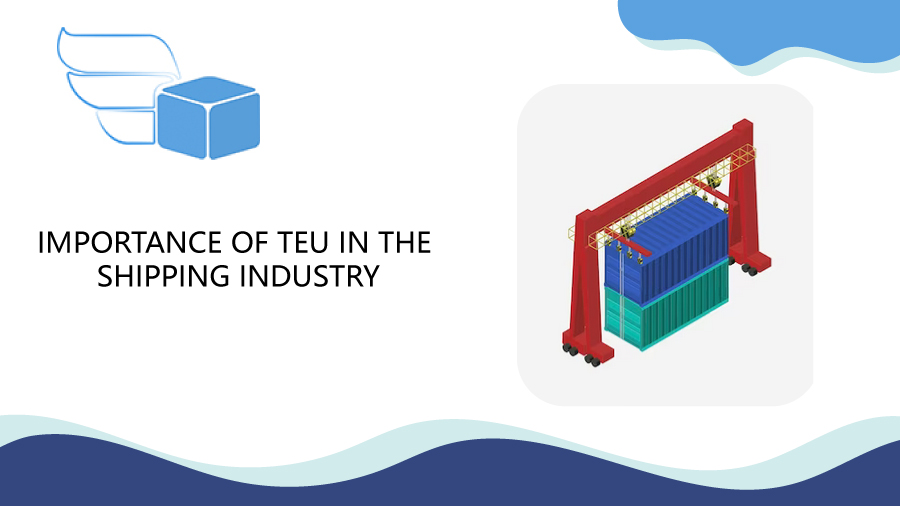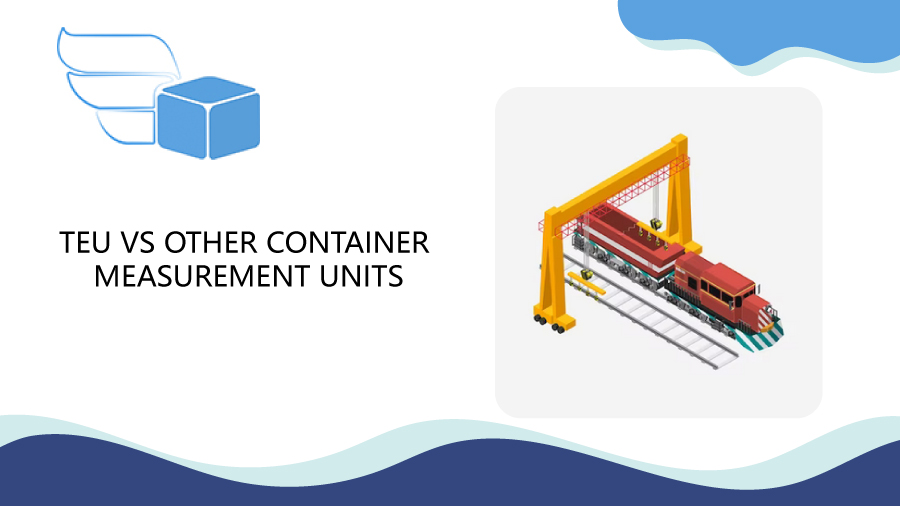What is TEU and how to calculate it?
Contents
Introduction to TEU (Twenty-foot Equivalent Unit)
The shipping industry is a complex network of vessels, ports, and cargo. At the heart of this industry lies the concept of containerization, which revolutionized the way goods are transported around the world. Containers have become the standard unit for cargo transportation, with millions of them being moved every day specially via sea freight. To efficiently manage this massive volume, a standardized measurement system was needed, and that’s where TEU, or Twenty-foot Equivalent Unit, comes into play.
TEU is a unit of measurement that represents the capacity of a standard 20-foot container. It allows shipping companies, port operators, and logistics providers to estimate the volume of cargo that can be transported or stored in a given space. The concept of TEU was introduced in the late 1960s and has since become the industry standard for container capacity measurement.
Understanding Container Capacity and TEU Measurement
Container capacity refers to the maximum amount of cargo that can be loaded onto a container vessel or stored in a container terminal. It is influenced by various factors such as the size and design of the vessel, the type of cargo being transported, and the infrastructure at the port. TEU measurement provides a standardized way to quantify container capacity, making it easier to compare and plan for different vessels and terminals.
A standard 20-foot container is assigned a value of 1 TEU. However, containers come in different sizes, such as 40-foot, 45-foot, and even 53-foot. In such cases, the capacity of the container is calculated based on its size relative to the standard 20-foot container. For example, a 40-foot container is considered as 2 TEUs, a 45-foot container as 2.25 TEUs, and a 53-foot container as 2.65 TEUs. This allows for a more accurate representation of the cargo capacity, considering the various container sizes used in the industry.
Calculating TEU is essential for planning and optimizing container transportation. It helps shipping companies determine the number of containers required for a particular voyage, estimate the revenue potential of a vessel, and allocate resources efficiently. Port operators also rely on TEU measurements to plan and allocate storage space in terminals, ensuring smooth operations and maximizing utilization.
Importance of TEU in the Shipping Industry
This method is of utmost importance in the shipping industry due to its wide-ranging applications. It provides a common language for all stakeholders involved in container transportation, enabling seamless communication and coordination. Here are some key reasons why TEU is crucial in the shipping industry:
- Standardization: TEU provides a standardized measurement system that allows for easy comparison and analysis of container capacity. This standardization facilitates efficient planning, resource allocation, and decision-making across the industry.
- Efficiency: By using TEU as a measure of container capacity, shipping companies can optimize their operations and maximize the utilization of vessels and terminals. This leads to cost savings, increased productivity, and reduced environmental impact.
- Global Trade Facilitation: The widespread adoption of TEU as a global standard has simplified international trade processes. It enables seamless integration of different modes of transportation, such as ships, trucks, and trains, by providing a common unit of measurement.
- Industry Trends and Analysis: TEU statistics and trends provide valuable insights into the global shipping industry. They help identify market dynamics, predict trade patterns, and inform investment decisions.

TEU Statistics and Trends
The use of TEU as a measurement unit has allowed for the collection and analysis of vast amounts of data related to container shipping. This data provides valuable insights into industry trends, trade patterns, and infrastructure development. Here are some key TEU statistics and trends:
- Global TEU Throughput: The total TEU throughput at major ports around the world has been steadily increasing over the years. This reflects the growth in global trade and the increasing reliance on container transportation.
- Regional Imbalances: TEU statistics also reveal regional imbalances in container trade. Some regions, such as Asia, have seen significant growth in TEU throughput, while others, like Africa, still have a relatively low containerization rate.
- Largest Container Ports: TEU statistics help identify the world’s largest container ports. Ports in China, such as Shanghai, Ningbo-Zhoushan, and Shenzhen, consistently rank among the top in terms of TEU throughput.
- Modal Shifts: TEU data can also shed light on modal shifts in container transportation. For example, the increasing use of larger vessels has led to a shift from traditional transshipment hubs to direct port calls.
Understanding these TEU statistics and trends is crucial for stakeholders in the shipping industry. It enables them to make informed decisions, identify growth opportunities, and adapt to changing market dynamics.
Factors Influencing TEU Calculation
The calculation of TEU involves considering various factors that influence container capacity. These factors can vary depending on the type of vessel, cargo, and infrastructure. Here are some key factors that influence TEU calculation:
- Container Size and Type: Different container sizes and types have different TEU values. Larger containers, such as 40-foot or 45-foot, have higher TEU values compared to standard 20-foot containers.
- Cargo Density: The density of the cargo being transported affects TEU calculation. Lighter cargo allows for more containers to be loaded, resulting in higher TEU values.
- Stowage Efficiency: The stowage efficiency of a vessel or terminal determines how effectively containers can be loaded and arranged. Efficient stowage increases the overall TEU capacity.
- Infrastructure Constraints: The infrastructure at ports and terminals, such as crane capacity and storage space, can limit the TEU capacity. Overcoming these constraints requires investments in infrastructure development.
By considering these factors, shipping companies and port operators can accurately calculate the TEU capacity of vessels and terminals. This information is crucial for effective planning, resource allocation, and operational efficiency.
Challenges and Limitations of TEU Measurement
While TEU has become the industry standard for container capacity measurement, it is not without its challenges and limitations. Here are some key challenges and limitations associated with TEU measurement:
- Container Variability: The wide variety of container sizes and types used in the industry makes it challenging to accurately calculate TEU. The conversion factors for different containers may vary, leading to inconsistencies in measurement.
- Cargo Compatibility: TEU measurement assumes that all cargo can be efficiently loaded into containers. However, certain types of cargo, such as oversized or hazardous goods, may require special handling and cannot be easily accommodated within standard containers.
- Infrastructure Constraints: The TEU capacity of vessels and terminals is influenced by infrastructure constraints, such as crane capacity, berth length, and storage space. These constraints can limit the overall TEU capacity and require investments in infrastructure development.
- Evolving Industry Needs: The shipping industry is constantly evolving, with new vessel designs, cargo types, and operational models emerging. TEU measurement may not fully capture the complexities and nuances of these evolving needs.
Despite these challenges and limitations, TEU remains the most widely used measurement unit for container capacity in the shipping industry. It provides a common language and facilitates efficient planning and resource allocation. However, stakeholders should be aware of these limitations and consider additional factors when making critical decisions related to container transportation.
TEU vs Other Container Measurement Units

TEU is not the only unit of measurement used in the shipping industry to quantify container capacity. There are other measurement units that serve specific purposes and cater to different container types. Let’s compare TEU with some of the other commonly used container measurement units:
- FEU (Forty-foot Equivalent Unit): FEU is used to measure the capacity of 40-foot containers. It is equivalent to 2 TEUs, as a 40-foot container takes up twice the space of a standard 20-foot container.
- NEU (Nominal Equivalent Unit): NEU is a unit of measurement used to calculate the capacity of non-standard containers. It takes into account the specific dimensions and characteristics of the container and provides a more accurate representation of its capacity.
- Gross Volume: Gross volume refers to the total internal volume of a container, including any empty space. It is measured in cubic meters or cubic feet and provides a more detailed understanding of the physical capacity of a container.
While these measurement units serve specific purposes, TEU remains the most widely used and recognized unit for container capacity measurement. It provides a standardized system that allows for easy comparison and analysis across the industry.
Innovations in Container Capacity and TEU Optimization
As containerization continues to play a vital role in global trade, innovations in container capacity and TEU optimization are constantly being explored. These innovations aim to address the challenges and limitations of TEU measurement and improve overall efficiency in container transportation. Here are some notable innovations in container capacity and TEU optimization:
- Larger Vessels: The introduction of larger container vessels, such as Ultra Large Container Ships (ULCS), has significantly increased container capacity. These vessels can carry thousands of TEUs, allowing for economies of scale and reduced carbon emissions per container.
- Efficient Stowage Systems: Advanced stowage systems and algorithms are being developed to optimize the arrangement of containers within vessels. These systems maximize space utilization and improve the overall TEU capacity of the vessel.
- Smart Containers: The use of smart containers equipped with sensors and tracking devices enables better monitoring of cargo and container conditions. This technology improves container utilization, reduces theft and damage, and enhances overall supply chain visibility.
- Intermodal Integration: Innovations in intermodal transportation, such as the development of rail and inland waterway connections, enhance the efficiency of container transportation. This integration allows for seamless movement of containers across different modes of transport, reducing transit times and costs.
By embracing these innovations, the shipping industry can further optimize container capacity and improve the accuracy of TEU measurement. This will lead to more efficient operations, reduced costs, and a more sustainable future for container transportation.
Conclusion
TEU, or Twenty-foot Equivalent Unit, is a crucial concept in the shipping industry. It provides a standardized way to measure container capacity and enables efficient planning and resource allocation. Understanding TEU and its calculation method is essential for shipping companies, port operators, and logistics providers.
TEU statistics and trends provide valuable insights into the global shipping industry, helping stakeholders make informed decisions and adapt to changing market dynamics. However, it is important to acknowledge the challenges and limitations associated with TEU measurement and consider additional factors when making critical decisions.
As the shipping industry continues to evolve, innovations in container capacity and TEU optimization are being explored. These innovations aim to address the limitations of TEU measurement and improve overall efficiency in container transportation.
By demystifying TEU and embracing these innovations, the shipping industry can continue to thrive and meet the growing demands of global trade.




Leave a Reply
Want to join the discussion?Feel free to contribute!